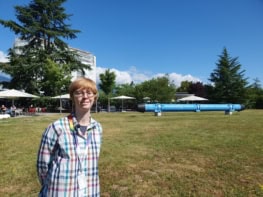More female decision-makers and family-friendly working practices are among the measures needed to encourage more women to take up careers in physics, according to resolutions agreed at the first International Conference on Women in Physics held in Paris earlier this month. Over 300 physicists unanimously approved eight recommendations – aimed at schools, universities, industry, government and funding councils – to enable women to contribute more effectively to physics.
Few women currently choose careers in physics, and of those that do, very few make it to the top of their chosen professions. The International Union of Pure and Applied Physics organised the Paris conference to uncover the reasons for this shortfall, and to develop strategies to tap this under-used pool of female talent. Eight resolutions emerged from the conference, addressing the particular problems that women face in education, employment and research.
Many of the general recommendations apply to a wide range of organizations, including universities, governments, industrial labs and research institutes. These measures include the provision of child-care facilities and flexible working hours. But crucially, these institutions must give equal consideration to men and women applying for jobs and promotion. Selection criteria should be freely available, and unfair practices must be abolished. The well-known ‘glass ceiling’ effect – in which few women reach senior positions – leads to a lack of female role models that further discourages women. Promoting more women to decision-making roles would help to enshrine in working practices an awareness of the problems faced by women.
Among the more specific recommendations were those to encourage girls and young women to study physics. One resolution calls upon schools and universities to highlight the positive effects that physics has on people’s lives, because research has shown that girls are strongly motivated to improve the lives of other people. Schools should also use teaching methods that interest both girls and boys.
Funding bodies must be more flexible when they allocate research grants. Lifting age restrictions on certain grants would help women who find that critical stages in their scientific careers – such as gaining experience through stints of post-doctoral research – coincide with their child-bearing years. Flexible periods of ‘family leave’ – without penalties – would help many women to integrate the birth of children with their research careers.
The crucial role of physics in the health of national economies was reflected in a recommendation that governments should make good physics education equally available to everybody. Governments should also appoint more women on to national planning committees, and allocate public funds only to organizations with active equal opportunities policies.
Scientific societies were called upon to identify women working in physics and publicize them as role models. Societies could also help by publishing data on the number of women working at all levels in physics. Working groups could be set up in each society to monitor women’s issues and make recommendations to the organization as a whole.
According to the results of a survey presented at the conference, marriage, family life and the attitudes of a minority of male physicists are the biggest barriers for women attempting to forge a career in physics. Statisticians at the American Institute of Physics questioned over 800 female physicists world-wide, and found that the employment prospects of many women are damaged by the difficulty of finding a job near their partner – the so-called two-body problem. Many women, however, cited the support of partners and other family members as crucial to their success as physicists.
Conference organizer Marcia Barbosa, a Brazilian physicist, has already pronounced the event a success. She believes that the networks established at the conference – consisting of 65 teams from all over the world – will enable female physicists to coordinate their efforts in future. “The Brazilian team hopes to organize another event in 2004,” she told PhysicsWeb. “We hope by then that we will see significant changes.”



